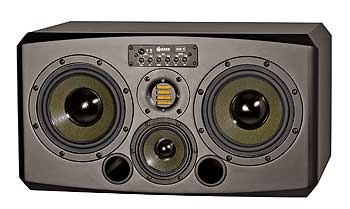
Controls are front-mounted for easy, fast room tweaking.
I’ve been intrigued by ADAM speakers since encountering them at AES Munich a decade ago. I was struck by company co-founder Klaus Heinz’ ART (Accelerating Ribbon Technology) folded-ribbon tweeter based on Dr. Oskar Heil’s 1972 Air Motion Transformer. Rather than the 1:1 ratio motion of a conventional piston-type HF unit (such as a cone or dome), the folded tweeter has a much larger surface area and creates air motion by squeezing the surrounding air in a 4:1 velocity ratio.
Ten years later, ADAM continues to refine its ART approach, resulting in the new X-ART (eXtended-ART) tweeter. Used in the new SX Series monitors, the X-ART driver exhibits greater efficiency, an additional 3dB power handling and HF response out to 50 kHz. The SX Series range from small two-way near-fields (S1X and S2X) to three-way mid-fields (S3X and S4X). The latter models are offered in vertical and horizontal versions, such as the S3X-H tested here.
More That’s New
Unlike ADAM’s mirror-imaged S3A and P33A monitors, which use dual woofers — with one voiced as a subwoofer and the other handling upper mid-bass and mids — the SX3-H is a more “conventional” three-way with two 7-inch woofers operating in the same frequency range, crossed over to a 4.5-inch Hexacone midrange at 350 Hz and the X-ART driver kicking in at 2.8 kHz. Also, the SX3-H’s non-mirror-imaged design simplifies using these in surround.
But the big changes are on the inside. The P33A had three 100-watt amplifiers; the SX3H packs three ICE 250W (350W peak) PWM amps to drive each woofer and the mid driver. A 50W (100W peak) Class-A/B analog amp that’s flat out to 300 kHz powers HF. Despite this horsepower, the SX3-H is a compact 21×11×13 inches (W×H×D) and each monitor weighs in at 43 pounds.
Note: The SX3-H woofers are spec’d as 7-inch and the mid as 4.5, yet the actual diameter of the cones — the moving part, not the basket frame — are 6 inches and 3.5 inches, respectively.
The twin-front ported, black-matte enclosure is gently radiused along the front baffle and sides. On the back panel are amp-cooling vents, an AC power switch and XLR analog input; 24-bit/192kHz digital inputs are optional.
In the Studio
All necessary controls for SX3-H operation are on the front panel. The AC standby switch let me leave the rear AC switch “on” all the time, then put the speakers in standby to avoid power-on “thumps” and use an AC strip rather than have to reach behind the SX3-Hs to turn them off. The standby is also useful for muting one side or the other while checking L/R elements in your mix.
Six front panel controls for tweaking setups include input sensitivity (fine and coarse), LF and HF. On the LF side, there’s a 0 to +6dB bass boost control at 80 Hz (which I never needed) and a ±4dB shelf filter at 150 Hz. HF offers a gentle ±4dB shelf above 6 kHz and tweeter level that’s ±2 dB in 0.5dB steps. All the controls are detented — a nice touch, but with no pointers or indicators on the knobs, you can’t tell from a glance whether the bass shelf is set at +0.5 or -4 dB.
Although the SX3-Hs are intended as mid-fields, I first tried using them in a near-field configuration with the monitors placed about five feet away in a 10×12-foot video edit suite. The results were pretty much disastrous. The room was far too small and the substantial LF from the SX3-Hs overwhelmed the space. In situations like this, ADAM’s two-way, single woofer SX2 would be a better choice.

Using the SX3-Hs in a medium-sized control room (15×18-foot with 10-foot ceiling) was a completely different experience. This particular room is fairly absorptive, and a slight HF gain (about 1.5 dB) was all the correction required. Here, the bottom end was tight and full, with no boominess whatsoever, and the mids were in perfect balance, whether in playbacks at 80 dB or 108 dB. The top end was natural, detailed and sweet, and with the X-ART tweeters I felt confident adding any air-band EQ to a track.
The monitors were on stands in the mid-field pocket (about six to seven feet back). At this distance, the top end was open, with the SX3-Hs creating the effect of a coherent, almost single-point source. The imaging was razor-sharp, creating a well-defined center and a nice sense of front-to-back soundstage.
With 800-plus watts of onboard amplification, the system is capable of SPLs exceeding 126 dB, offering plenty of headroom, which adds to the SX3-H’s superb transient response. Despite all that punch, any amp noise was almost undetectable and the SX3-Hs provided long sessions without listening fatigue. And besides simply sounding right, mixes made on the SX3-Hs translated effortlessly to other systems.
At $6,800 pair, the ADAM Audio SX3-Hs are clearly not for everyone. However, anyone seeking an uncompromised solution to studio monitoring should put these on the short list of products to consider.







